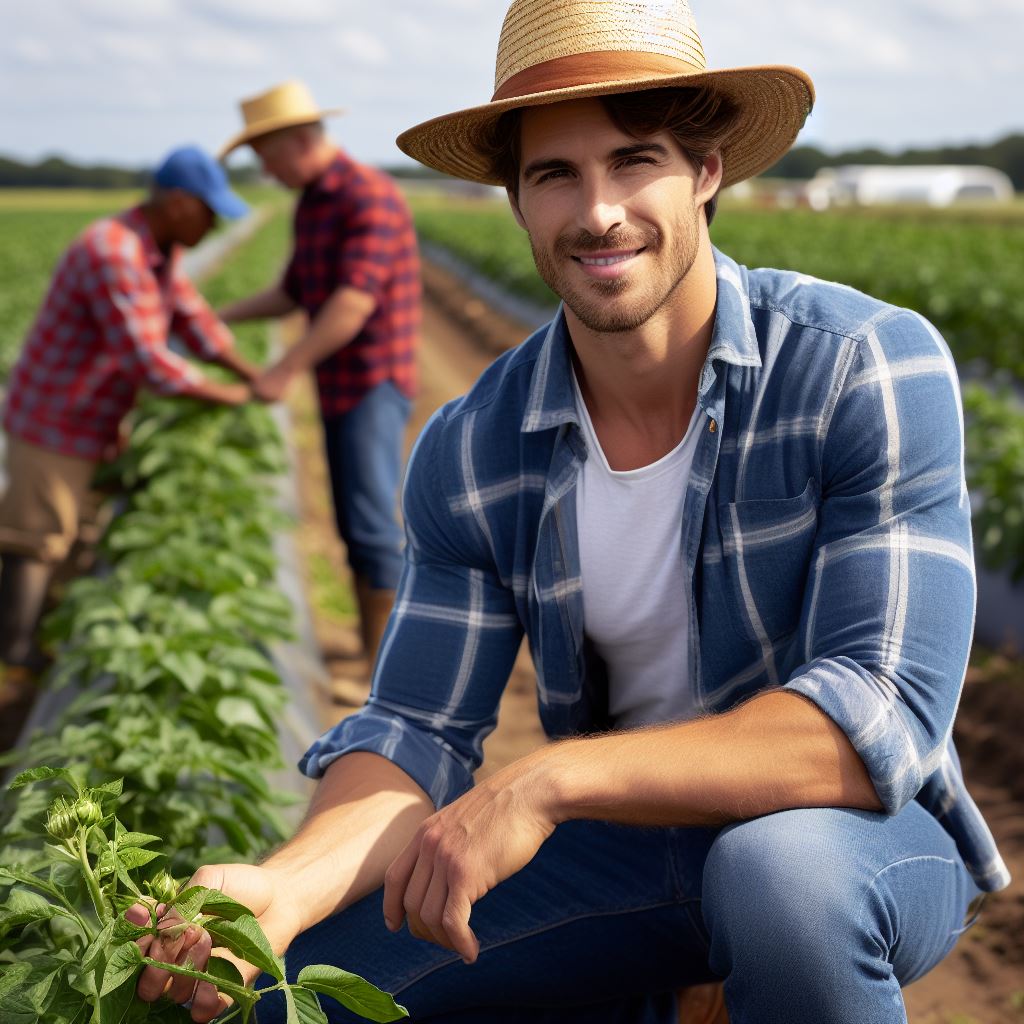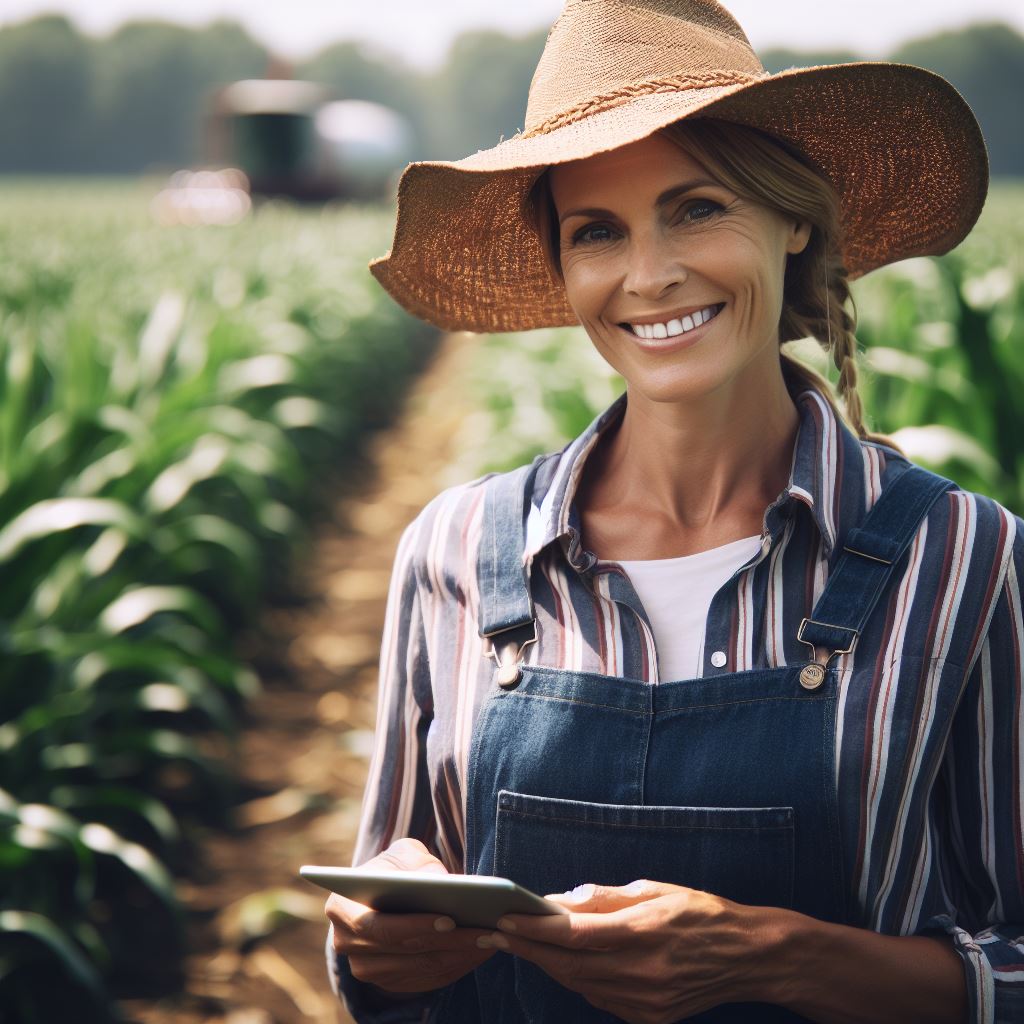Introduction
The importance of agriculture in the United States
The Farmer Battle Against Climate Change and Weather is what we will discuss in this article.
In the United States, agriculture plays a crucial role in the economy and food production. Farmers face growing concerns about climate change and its impact on their livelihoods.
With changing weather patterns and extreme events becoming more frequent, the agricultural industry is under threat.
The effects of climate change, such as droughts, floods, and heatwaves, are jeopardizing crop yields and livestock health.
Farmers are finding it increasingly difficult to adapt and mitigate the risks posed by these climate-related challenges.
Concerns about climate change and its impact on farmers
As extreme weather events become more common, farmers are struggling to make decisions regarding planting, irrigation, and pest control.
Unpredictable weather patterns disrupt traditional growing seasons and increase the risks of crop failure. The changing climate also affects soil health, making it more susceptible to erosion and depletion of nutrients.
In addition, extreme temperatures and erratic rainfall patterns impact livestock, causing stress, diseases, and reduced growth rates. Considering Farmer Battle Against Climate Change and Weather.
To combat these challenges, farmers are adopting various strategies and technologies.
They are implementing conservation practices to enhance soil health and water management, using precision agriculture techniques, and exploring alternative crops that are more resilient to changing weather patterns.
Additionally, they are investing in weather monitoring systems and climate forecasting to improve their decision-making process.
Furthermore, farmers are advocating for more sustainable and climate-smart policies, urging the government to prioritize the agricultural sector’s resilience to climate change.
They are also collaborating with researchers and agricultural institutions to develop innovative solutions that can help them adapt and mitigate the effects of climate change.
In review, the impact of climate change on US farmers is a grave concern. With changing weather patterns and extreme events, agricultural productivity is under threat.
However, farmers are fighting back by adopting sustainable practices and advocating for policies that prioritize their resilience to climate change.
By embracing innovation and collaborating across sectors, they are striving to secure the future of US agriculture. Considering the farmer’s battle against climate change and weather
Understanding climate change
Explanation of climate change and its causes
Climate change refers to long-term shifts in weather patterns and temperatures across the globe. It is primarily caused by human activities, including the burning of fossil fuels and deforestation.
These activities release greenhouse gases, such as carbon dioxide, into the atmosphere, trapping heat and causing the Earth’s temperature to rise.
Global and regional effects of climate change
The effects of climate change are felt globally, impacting both natural ecosystems and human societies.
Rising temperatures lead to melting glaciers, sea-level rise, and more frequent extreme weather events like hurricanes and heatwaves. Considering Farmer Battle Against Climate Change and Weather.
This affects agriculture, water resources, and biodiversity, causing disruptions to food production and threatening livelihoods.
Regionally, the impacts vary. Coastal regions face the risk of flooding due to rising sea levels. Dry areas are prone to droughts, leading to water scarcity and desertification.
Mountainous regions experience changes in snowfall patterns, impacting water availability downstream. In some areas, increased rainfall can lead to flooding and landslides.
Climate change predictions for the United States
The United States is not immune to the impacts of climate change. As temperatures continue to rise, various regions will face unique challenges.
The Arctic region in Alaska is expected to experience the most significant changes, with melting permafrost and loss of sea ice threatening indigenous communities and wildlife.
In the western states, climate change will exacerbate drought conditions, increasing the risk of wildfires and impacting agriculture and water supplies.
Coastal regions, such as Florida and the Gulf Coast, will experience higher sea levels, leading to increased flooding and erosion. Considering Farmer Battle Against Climate Change and Weather.
The Midwest and Northeast will also face challenges, including more frequent and severe heatwaves, heavy rainfall events, and increased risks of pests and diseases.
These changes will negatively impact crop yields, infrastructure, and overall public health.
Climate models predict that extreme weather events will become more frequent and intense in the future.
This includes hurricanes becoming stronger and lasting longer, resulting in more destructive storm surges.
The intensity and frequency of tornadoes may also increase in certain regions.
To mitigate the impacts of climate change, it is crucial for the United States to take immediate action to reduce greenhouse gas emissions.
Implementing clean energy sources, adopting sustainable agricultural practices, and investing in resilient infrastructure are essential steps towards minimizing the effects of climate change.
In general, understanding climate change and its causes is vital for addressing the challenges it presents. The global effects of climate change impact ecosystems and human societies across the world.
In the United States, regions will experience different impacts, including rising sea levels, droughts, and extreme weather events. Considering Farmer Battle Against Climate Change and Weather.
By taking action to reduce emissions and adapt to changes, the U.S. can contribute to a more sustainable and resilient future.
Challenges faced by US farmers
Increased frequency and intensity of extreme weather events
Extreme weather events such as hurricanes, tornadoes, and droughts have become more frequent and severe in recent years. Considering Farmer Battle Against Climate Change and Weather.
These events pose a significant risk to agricultural operations, damaging crops, infrastructure, and equipment.
Farmers must constantly adapt their farming practices to mitigate the impact of these extreme weather events.
Transform Your Career Today
Unlock a personalized career strategy that drives real results. Get tailored advice and a roadmap designed just for you.
Start NowChanges in rainfall patterns and precipitation levels
Climate change has disrupted traditional rainfall patterns, leading to irregular and unpredictable precipitation levels.
Some regions are experiencing more frequent and intense rainfall, resulting in flooding and soil erosion.
In contrast, other areas are facing extended periods of drought, leading to water scarcity and crop failure.
Rising temperatures and heatwaves
Global warming has caused a steady increase in temperatures, resulting in heatwaves that can be detrimental to crops.
High temperatures accelerate evaporation, leading to soil moisture loss and increased water demands for irrigation.
Heat stress can also reduce plant productivity and cause yield losses, affecting the profitability of farming operations.
Impact of climate change on crop yields and quality
Climate change poses a significant threat to crop yields and quality due to its influence on various factors.
Changing temperatures, rainfall patterns, and extreme weather events can disrupt pollination, flowering, and fruit development.
Pests, diseases, and weed infestation are also likely to increase with changing climate conditions, further affecting crop productivity.
Economic losses for farmers due to climate-related events
Farmers bear the brunt of economic losses caused by climate-related events such as crop damage and yield reductions.
Crop insurance premiums are rising due to increased risks, making it financially burdensome for farmers to protect their investments.
Moreover, they may face difficulties in accessing credit and loans due to the uncertainties surrounding future climate conditions.
In addition, US farmers face various challenges due to climate change and weather-related events.
The increased frequency and intensity of extreme weather events, changes in rainfall patterns and precipitation levels, rising temperatures and heatwaves,
The impact on crop yields and quality, and the economic losses they experience highlight the urgent need for proactive adaptation strategies.
Farmers must adopt sustainable and resilient practices, diversify their crops, improve irrigation techniques.
And invest in climate-smart technologies to mitigate the risks associated with climate change and secure their livelihoods.
Read: Challenges & Triumphs: Agricultural Engineering Case Studies
Strategies employed by farmers to mitigate climate change’s effects
Climate change is an urgent global problem that has severe consequences on different sectors, including agriculture.
The agricultural industry, particularly in the United States, is increasingly feeling the impacts of changing weather patterns and extreme climatic events.
However, farmers are not helpless in the face of climate change. They have been proactive in employing various strategies to mitigate its effects and build resilience within their farming systems.
Conservation agriculture practices
- Use of cover crops and crop rotations: Farmers have been integrating cover crops into their farming systems to improve soil health, reduce erosion, and sequester carbon.
By rotating crops, they break pest and disease cycles, enhance nutrient cycling, and improve water. - Reduced tillage and soil erosion prevention: Farmers are adopting reduced tillage practices to minimize soil disturbance and erosion.
By reducing the number of times the soil is tilled, they preserve soil structure, moisture, and beneficial microorganisms, while also minimizing carbon emissions.
Adoption of climate-smart farming techniques
- Diversification of crops and livestock: To adapt to changing climatic conditions, farmers are diversifying their crops and livestock.
This helps spread the risks associated with extreme weather events and market fluctuations. It also allows farmers to take advantage of emerging market trends and consumer demands. - Improving water and nutrient management: Farmers are implementing efficient irrigation techniques and precision nutrient applications to optimize water and fertilizer use.
This not only reduces costs but also minimizes nutrient runoff and water pollution, benefiting both the environment and the farm’s productivity. - Precision farming and data-driven decision-making: With the help of advanced technologies and data analysis, farmers can make more informed decisions regarding planting, fertilizing, and pest management.
Precision farming practices enable them to target specific areas of their fields, optimizing resource allocation, reducing waste, and minimizing environmental impacts.
Investment in renewable energy sources
- Utilizing solar power and wind turbines: Many farmers are installing solar panels and wind turbines, capitalizing on renewable energy sources to fulfill their energy needs.
This not only reduces their reliance on fossil fuels but also helps reduce greenhouse gas emissions associated with fossil fuel combustion. - Reducing greenhouse gas emissions: By implementing sustainable management practices, such as optimizing fertilizer use, managing livestock waste, and improving energy efficiency, farmers can significantly reduce their greenhouse gas emissions.
This contributes to mitigating climate change and demonstrating their commitment to environmental stewardship.
In short, US farmers are actively adopting various strategies to mitigate the effects of climate change on their farming operations.
They are implementing conservation agriculture practices, adopting climate-smart farming techniques, and investing in renewable energy sources.
These proactive measures not only help farmers navigate the challenges posed by changing weather patterns but also contribute to building a more sustainable and resilient agricultural sector.
By prioritizing sustainable practices and embracing innovation, farmers are playing a crucial role in the battle against climate change and ensuring the long-term viability of their farms.
Read: A Day in the Life: Following a US Agricultural Engineer

Collaboration and knowledge-sharing initiatives
Farmer-driven organizations and cooperative networks
Farmer-driven organizations and cooperative networks play a crucial role in battling climate change and extreme weather conditions.
These organizations bring together farmers from different regions, allowing them to share their experiences, knowledge, and strategies to adapt to changing climate patterns.
Through collaborative efforts, these groups work towards finding sustainable and climate-resilient farming techniques.
Research institutions and government agencies
Research institutions and government agencies also contribute to the fight against climate change and its impact on agriculture.
They conduct studies and experiments to understand the effects of climate change on crops, soil, and livestock.
These institutions provide vital information and data that help farmers make informed decisions and implement effective mitigation and adaptation strategies.
Showcase Your Business Today
Reach thousands of readers actively exploring professional services. Publish your business profile and grow your audience now.
Publish NowExchanging best practices and scientific findings
Collaboration between farmers, researchers, and policymakers promotes the exchange of best practices and scientific findings.
In conferences, seminars, and workshops, farmers share their successful techniques and learn from each other’s experiences.
This knowledge transfer helps farmers adopt innovative practices that can enhance their agricultural productivity and resilience to climate change.
Farmers engaging in climate advocacy and policy discussions
Farmers are increasingly engaging in climate advocacy and policy discussions at local, national, and international levels.
They voice their concerns, share their experiences, and contribute their expertise to shape policies and interventions that support sustainable agriculture.
By actively participating in these discussions, farmers ensure their perspectives are heard, and their needs are addressed in climate change adaptation and mitigation strategies.
Overall, collaboration and knowledge-sharing initiatives are fundamental in the battle against climate change and its impact on agriculture.
By engaging in farmer-driven organizations, exchanging best practices, and actively participating in policy discussions, farmers can collectively strive towards climate-resilient farming practices.
Research institutions and government agencies provide crucial support by conducting studies, generating data, and facilitating the dissemination of scientific findings.
Together, these collaborative efforts can pave the way for a sustainable and climate-resilient agricultural sector.
Read: The Impact of Climate Change on US Agricultural Engineering
Success stories of US farmers dealing with climate change
Case studies of resilient farming practices
US farmers have been implementing resilient farming practices to minimize the impact of climate change on their operations. These case studies demonstrate the success of their efforts:
- Diversification: Many farmers have diversified their crops to reduce their dependency on specific plants that may be more vulnerable to climate change.
This strategy has allowed them to adapt to changing weather patterns. - Improved water management: Farmers have implemented advanced irrigation systems and water-conservation techniques to cope with droughts and unpredictable rainfall.
This has enabled them to maintain crop productivity even during dry spells. - Soil conservation: Soil erosion and degradation can be exacerbated by climate change, but farmers have implemented conservation practices such as cover cropping and reduced tillage.
These methods help prevent soil erosion and improve soil health. - Integrated pest management: Changing climate conditions can lead to an increase in pest populations. Rather than relying solely on chemical pesticides, farmers have adopted integrated pest management strategies that involve the use of beneficial insects and crop rotation to control pests.
Testimonials from farmers who have adapted to changing climate conditions
Real-life testimonials from US farmers provide inspiring insights into their experiences and solutions in dealing with climate change
I used to exclusively grow corn, but after experiencing several years of extreme heat and drought, I decided to diversify my crops.
Now I grow corn, soybeans, and wheat, which has reduced my risk and stabilized my income. – John, Iowa farmer
Managing water resources has become crucial for us. We’ve invested in drip irrigation systems that allow us to precisely control water distribution.
This has not only saved water but also improved our crop yields. – Maria, California farmer
With the increasing pest pressure caused by climate change, I’ve shifted towards integrated pest management practices.
By introducing beneficial insects and practicing crop rotation, pesticide use has significantly reduced. – Michael, Kansas farmer
Innovative solutions implemented by farmers to overcome challenges
US farmers have continuously sought innovative solutions to combat climate change. Here are some of the pioneering strategies they have implemented:
- Use of precision agriculture: GPS technology is employed to precisely apply fertilizers and pesticides, reducing waste and improving efficiency.
- Adoption of climate-resilient crop varieties: Farmers are selecting and planting crop varieties that are more resilient to extreme weather conditions.
- Rainwater harvesting systems: By capturing and storing rainwater, farmers can mitigate water scarcity during drought periods.
- Renewable energy integration: Some farmers have installed solar panels and wind turbines, enabling them to generate clean energy to power their operations.
To summarize, US farmers have demonstrated their resilience and determination in the face of climate change.
Through case studies, testimonials, and the implementation of innovative solutions, they have successfully adapted to the changing climate conditions.
These success stories serve as inspiration for other farmers and emphasize the importance of proactive initiatives in the battle against climate change.
Read: Emerging Technologies in US Agricultural Engineering
Future outlook and challenges ahead
As the battle against climate change and extreme weather conditions continues, the future of US farmers hangs in the balance.
It is essential to address the challenges ahead and formulate effective strategies for their survival and success.
The importance of continuous adaptation and innovation
Adaptation and innovation are critical for farmers to overcome the adverse effects of climate change.
They must stay ahead of the changing climate patterns, evolving pests, and diseases, and find innovative solutions to ensure the productivity and profitability of their farms.
Farmers need to constantly evaluate their practices and adopt climate-resilient techniques.
This may include implementing precision agriculture methods, using drought-tolerant and heat-resistant crop varieties, and practicing soil conservation measures to mitigate erosion and nutrient loss.
Continuous adaptation and innovation will be the key to sustain agricultural production in the face of a changing climate.
Integrating climate change considerations into agricultural policies
It is crucial for agricultural policies at local, state, and federal levels to incorporate climate change considerations.
These policies should aim to support farmers in their efforts to adapt to changing climate conditions and mitigate greenhouse gas emissions from agricultural activities.
Government agencies and policymakers need to provide resources and guidance to help farmers access information, technology, and tools that can aid in climate change adaptation.
This includes promoting research and development of climate-resilient crop varieties, facilitating the sharing of best practices, and offering incentives for adopting climate-smart agriculture.
Need for financial support and incentives for climate-smart farming
Transitioning to climate-smart farming practices often requires upfront investments and financial resources. Farmers need financial support and incentives to make these transitions economically feasible.
Government programs can play a vital role in providing grants, loans, and tax incentives to farmers who adopt climate-smart practices.
These incentives can help cover the costs of implementing new technologies, purchasing equipment, and undergoing training to effectively adapt to climate change.
Financial support will encourage more farmers to embrace sustainable agricultural practices and increase their resilience to climate-related challenges.
Collaboration between farmers, scientists, and policymakers to combat climate change
Addressing the complex challenges posed by climate change requires a collaborative effort between farmers, scientists, and policymakers.
Farmers can provide invaluable practical insights based on their experience, while scientists can contribute their expertise in developing and disseminating climate-resilient farming techniques.
Policymakers play a crucial role in creating an enabling environment, establishing research funding, and implementing supportive policies to incentivize climate-smart farming.
Collaboration platforms such as farmer-scientist networks and stakeholder dialogues need to be created to facilitate knowledge sharing and collaboration.
By joining forces, these stakeholders can develop holistic strategies that integrate local knowledge, scientific advancements, and policy measures to combat climate change together.
To sum it up, the future of US farmers lies in their ability to adapt and innovate in the face of climate change and extreme weather conditions.
It is crucial to integrate climate change considerations into agricultural policies, provide financial support and incentives for climate-smart farming, and foster collaboration among farmers, scientists, and policymakers.
By implementing these strategies, US farmers can enhance their resilience and contribute to the larger effort of fighting climate change for a sustainable agricultural future.
Conclusion
Impact of climate change on US farmers
Climate change is wreaking havoc on US farmers, causing extreme weather events, crop failures, and financial losses in the Farmer Battle Against Climate Change and Weather
Resilience and determination of farmers in the face of adversity
Despite these challenges, farmers are showing remarkable resilience and determination, adapting their practices and finding innovative solutions. Farmer Battle Against Climate Change and Weather
Encouragement
It is crucial for readers to support sustainable and climate-smart agriculture practices to mitigate the effects of climate change and ensure a secure food future.
Supporting farmers who are implementing practices like conservation agriculture, crop rotation, and precision farming can make a significant difference.
By choosing local and sustainably-grown food, consumers can also play a crucial role in supporting climate-friendly agriculture.
Together, we can create a more resilient and sustainable agricultural system that can withstand climate change and ensure food security for future generations.
[E-Books for Sale]
The Big Book of 500 High-Paying Jobs in America: Unlock Your Earning Potential
$19.99 • 500 High-Paying Jobs • 330 pages
Explore 500 high-paying jobs in America and learn how to boost your career, earn more, and achieve success!
See All 500 High-Paying Jobs of this E-Book
1001 Professions Without a Degree: High-Paying American Jobs You Can Start Now
$19.99 • 1001 Professions Without a Degree • 174 pages
Discover 1001 high-paying jobs without a degree! Unlock career tips, skills, and success strategies for just $19.99!




